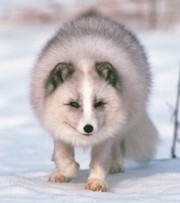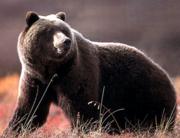*Here is a list of the predators to the wolves. Those of equal or greater power*
--
Arctic FoxCommon Names: Polar Fox, White Fox
Genus: Lagopus
Species: alopex

The North American tundra is located at latitudes 60° to 85° North and longitudes 55° to160° West which includes northern parts of Canada and the state of Alaska. The tundra is a cold barren wasteland that includes snow, rocks and very little variety in vegetation. It is in this place where the Arctic fox is found.
The Arctic fox (Alopex lagopus) makes its home in small burrows in frost-free ground, often in low mounds, or in rock piles. Because the Arctic fox is a scavenger it can usually find food to eat. Sometimes the fox will follow Polar bears or other predators and feed off the remains they leave behind.
The Arctic fox is about 10 -16 inches long and weighs about 6-12 pounds. It is about the size of an ordinary domesticated house cat. It has short legs a long bushy tail that it uses as insulation by wrapping it around itself when sleeping. Its long hair is white in the winter, and "blue" or gray in the summer. Its head has a stubby muzzle, small ears, and large eyes. Its feet are lined with fur, which helps it conserve heat. The Arctic fox has adapted a stealthy movement due to its predatory nature.
Both male and female mature sexually at one year of age. The mating season is May-February and the gestation period for a pregnant female is 52 days. The number of pups born can range between 6-19, and the newborns weigh approximately 2 ounces. Whelps are helpless and blind when first born. They nurse until they can eat solid food. Both parents care for the pups. The mother raises the young while the father hunts for lemmings and other food. They start to eat solids after 6 weeks and leave the den after 14-15 weeks. The whelp is usually dependent on its parent from summer to fall. Mortality rates for young foxes is very high. An average life span for the arctic fox is around three years.
The Arctic fox is a solitary animal. Arctic foxes usually live to 15 years of age. It is an omnivore (one who eats both plants and animals). A typical diet of this fox consists of birds, eggs, small mammals and fish. It will also eat berries, seaweed, insects and larvae, when other prey is scarce. The Arctic fox is a predator to lemmings (one of it's favorite foods) and voles, among other creatures. The population cycles of lemmings and voles are largely dependent on the arctic fox. The fox is prey to wolves, polar bears and golden eagles. Because it is a scavenger, it keeps the environment clean by eating dead animals and keeping the rodent population down. The Arctic fox is a diurnal creature.
The Arctic fox has adapted to its environment by growing long fur that changes color with the season for camouflage. It tends to eat whatever is available. It s movements are stealthy due to lack of cover on the tundra. Its legs, ears, and muzzle are short to conserve heat, and uses its tail like a muffler when cold.
Grizzly BearGenus: Ursus
Species: arctos horribilis

Most bears are found in North America and Eurasia. Grizzlies are found on the Alaskan and northwestern Canadian tundra. They are considered a subspecies of the brown bear. Most grizzly bears are found in the northwestern part of North America. The grizzly bear's habitat can include forests, mountains, meadows, and valleys.
Grizzly bears have amazing physical strength and are surprisingly fast over
short distances. They are very aggressive and have no trouble driving away predators like wolves and mountain lions. The grizzly also has a great sense of smell.
The grizzly has a heavy, stout body, a big head, and short tail. It has a distinctive hump between its shoulder blades. Its nose is dished, and turns up at the end, unlike the black bear, whose nose arches down. Most are brown, black, or blond. The tundra grizzly is often creamy yellow on the back with brownish legs and underparts. They can weigh up to 704 lbs, be over 8 feet in length, and stand 3 1/2 feet high at the shoulders. They are well suited to the cold climate of the tundra. Besides having a thick, shaggy coat of hair, they have layers of fat to insulate them. When winter comes the grizzly will bed down in a den packed with leaves and sticks. It doesn't go into full hibernation, and will occasionally come out of its den. It doesn't eat during this time but lives off stored body-fat until spring.
Grizzly bears have an amazing diet. Scientists discovered that 75% of the bear population live off plants alone. The grizzly will also eat insects, small rodents and honey. It is strong enough to kill a caribou and outrun a moose, but usually it doesn't hunt. It will eat abandoned kills made by other predators (by driving the predator away from its kill).
Females have cubs at around age five. She will give birth to 2 - 4 cubs, but usually twins in January. They weigh about 1 lb at birth and will suckle until May. The cubs stay with the mother until age 2 and then go off alone and repeat the cycle. Their life span is around 25 years.
The grizzly bear is a solitary animal because it doesn't need to form protective packs because it lacks natural enemies.
Musk OxCommon Name: Oomingmak
Genus: Ovibos
Species: moschatus

The musk ox live in the frozen tundra of northern, Alaska, Canada, Ellesmere Island, Greenland, Norway, Sweden and Siberia. No other hoofed animal lives as far north as the musk ox.
The musk ox can live in the harsh conditions of the arctic tundra because its 24" long hair and woolly undercoat ward off frost andprovide insulation. It has a sturdy build. It looks like a huge dust mop on hooves, their long hair
reaching almost to the ground. Its muzzle is usually white. It can weigh from 396-880 pounds, and reach a length of 7 feet. The musk ox gets its name from the odor produced by glands beneath the bull's eyes. The male has thick horns that almost meet on top of its head in what is called a "boss". The horns curve down besides its face and out at the ends. The female has smaller horns, without a boss. Instead the top of her head is covered with whitish hair.
In the summer the musk ox herd has about 10 members. They will use the almost constant daylight to stuff themselves on plants. They need to put on enough fat to get them through the long winter. In winter the herd can have about 15 to 20 members. They will head out to higher ground where the fierce Arctic winds blow the snow off the ground. Here they will feed on crowberry, bearberry, and willow. The herd only travels about 50 miles between its summer and winter feeding areas.
Breeding season starts in July and goes on until the end of August. Each herd has a dominant male, or bull, who will try to keep other bulls from mating with the females. The female will give birth to one calf the following April through June. The calf can graze in about a week but keeps suckling for another year. The lifespan of a musk ox is about 24 years.
Muskoxen coexisted with the mastodons and mammoths and have survived early hunters and climate changes that caused the extinction of other species. The musk ox doesn't have many predators. Polar bears can sometimes kill weak or injured oxen. The Arctic wolf is the only serious predator.
Musk ox form a defensive formation when threatened. They will first run to a higher location, then turn and stand shoulder-to-shoulder in a circle. With their heads lowered, they form an impenetrable wall. The young are protected in the center of the circle. Musk oxen stampede easily and sometimes young calves become separated from the herd and are lost.
More ominous as far as the decline of the musk ox is concerned are the effects global warming has had on their breeding. In the past few years, as a result of warmer climates, the coastal plains used as calving grounds have had more snow, and as a result, a later thaw. Musk oxen have moved to the foothills to find forage and often give birth there, making them and their calves more vulnerable to grizzly bears.
Polar BearCommon Names: Sea Bear
Genus: Ursus
Species: maritimus

Polar bears can be found all through the polar regions of the Northern hemisphere. They are the largest carnivore on land.
They have a black nose and eyes. They have two layers of fur which is so warm that adult bears can easily overheat when they run. The polar bear's fur is really clear, not white. Some light reflects off the fur and makes it look white. Most of the sun's rays reach their black skin, which
absorbs the heat and keeps the polar bear warm. The adult's fur looks darker than the cub's fur.
Their teeth and claws are very sharp so they can catch their prey easily (seal). Their shoulder height can be five feet or more and when they are standing up, their height can be 8-11 feet. Females weigh 660-770 lbs and males weighs 880-990 lbs. Polar bears spend most of their time on drifting packs of ice, eating, and resting.
The bears reach sexual maturity 3 to 5 years after birth. They usually mate in March and have their cubs 7 to 8 months later. Each year pregnant polar bears dig a den in the snow of southern facing slopes, where they give birth. The females gives birth to one or two cubs. Cubs are usually born in December or January. They are naked, blind and deaf. They stay in their den with their mother until March or early April. Then they emerge from the dens. After a few days of getting used to the outside environment, they take little trips to strengthen the cubs. The families then move back to the sea ice and hunt for seals and other prey. The cubs learn how to hunt with their mothers for about two and a half years. They live for 15 to 20 years. Polar bears live alone, except for mothers who live with their cubs.
Polar bears adapt very well to the cold. Ursus Maritimus means "sea bear". The polar bear has a thick layer of blubber around 4.5 inches thick. That and the hollow shafts of their hair provides them with excellent insulation. This allows them to handle temperature of -34°F. Their ears and tail are very short so they don't lose any heat through them. They have a very good sense of smell. Their necks are longer than other bears to keep their head above the water when they swim. They have strong legs and partially webbed front feet to help them swim. Their feet can be up to twelve inches in diameter.
They hunt and eat seals and other sea life. The polar bear is a predator. It hunts and eats meat. The polar bear mostly eats ringed seals, which are very abundant. Adult ringed seal can grow to 4.1 feet in length and weigh 150 pounds. The bears also eat whale and walrus carcasses. In the summer they will also eat lemmings, arctic foxes and ducks. Like all bears they will also eat some plants.